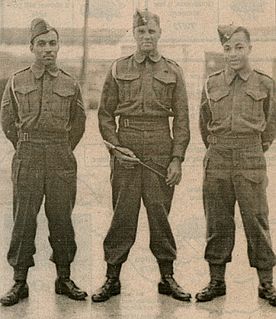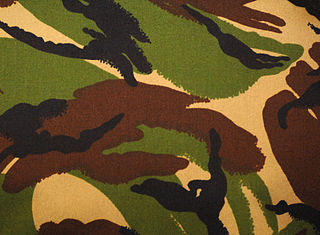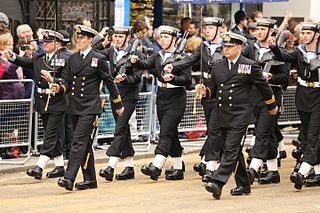 W
WThe Albert shako was an item of headgear worn in the British Army between 1844 and 1855. It was a development of the Albert hat proposed by Prince Albert in 1843 as a replacement for the bell-top shako then in use. The Albert hat was 7+1⁄10 inches (18 cm) tall, 7⁄10 inch (1.8 cm) taller than the bell-top shako, and had a brim all around rather than just a peak to provide better protection from the sun. The hat included innovative ventilation features.
 W
WThe uniforms of the British Army currently exist in twelve categories ranging from ceremonial uniforms to combat dress. Uniforms in the British Army are specific to the regiment to which a soldier belongs. Full dress presents the most differentiation between units, and there are fewer regimental distinctions between ceremonial dress, service dress, barrack dress and combat dress, though a level of regimental distinction runs throughout.
 W
WThe British Army used a variety of standardized battle uniforms and weapons during World War I. According to the British official historian Brigadier James E. Edmonds recorded in 1925, "The British Army of 1914 was the best trained best equipped and best organized British Army ever sent to war". They were the only army to wear any form of a camouflage uniform; the value of Drab (color) clothing was quickly recognised by the British Army, who introduced Khaki drill for Indian and colonial warfare from the mid-19th century on. As part of a series of reforms following the Second Boer War, a darker khaki serge was adopted in 1902, for service dress in Britain itself. On the whole, the British military authorities showed more foresight than their French counterparts, who retained highly visible blue coats and red trousers for active service until the final units received a new uniform over a year into World War I. The soldier was issued with the 1908 Pattern Webbing for carrying personal equipment and he was armed with the Short Magazine Lee–Enfield rifle.
 W
WBattledress was the specific title of a military uniform adopted by the British Army in the late 1930s and worn until the 1960s. Several other nations also introduced variants of battledress during the Second World War, including Australia, Canada, India, New Zealand, South Africa, and the United States of America and after the Second World War, including Argentina, Belgium, Norway, the Netherlands, and Greece.
 W
WA British Warm, British warm or British Warm overcoat is a type of woollen overcoat based on the greatcoats worn by British Army officers in the First World War.
 W
WA cap badge, also known as head badge or hat badge, is a badge worn on uniform headgear and distinguishes the wearer's nationality and/or organisation. The wearing of cap badges is a convention commonly found among military and police forces, as well as uniformed civilian groups such as the Boy Scouts, civil defence organisations, ambulance services, customs services, fire services etc.
 W
WThe Denison smock was a coverall jacket issued to Special Operations Executive (SOE) agents, the Parachute Regiment, the Glider Pilot Regiment, Air Landing Regiments, Air Observation Post Squadrons, Commando units, and other Commonwealth airborne units, to wear over their Battle Dress uniform during the Second World War. The garment was also issued as standard to the scout and sniper platoons of line infantry battalions.
 W
WDisruptive Pattern Material (DPM) is the commonly used name of a camouflage pattern used by the British Armed Forces as well as many other armed forces worldwide, particularly in former British colonies.
 W
WThe Glengarry bonnet is a traditional Scots cap made of thick-milled woollen material, decorated with a toorie on top, frequently a rosette cockade on the left side, and ribbons hanging behind. It is normally worn as part of Scottish military or civilian Highland dress, either formal or informal, as an alternative to the Balmoral bonnet or Tam o' Shanter.
 W
WKhaki drill (KD) was the British military term for a type of fabric and the military uniforms made from them.
 W
WMess dress uniform is the most-formal or semi-formal type of uniforms used by military personnel, police personnel and other public uniformed services members for certain ceremonies, receptions, and celebrations, in messes or on private occasions. It frequently consists of a mess jacket, trousers, white dress shirt, often with standing collar and bow tie, along with orders and medals insignia. Design may depend on regiment or service branch, e.g. army, navy, air force, marines, etc. In Western dress codes, mess dress uniform is a permitted supplementary alternative equivalent to the civilian black tie for evening wear or black lounge suit for day wear - sometimes collectively called half dress - although military uniforms are the same for day and evening wear. As such, mess dress uniform is considered less formal than full dress uniform, but more formal than service dress uniform.
 W
WThis is a list of equipment of the British Army currently in use. It includes small arms, combat vehicles, aircraft, watercraft, artillery and transport vehicles. The British Army is the principal land warfare force of the United Kingdom, a part of British Armed Forces. Since the end of the Cold War, the British Army has been deployed to a number of conflict zones, often as part of an expeditionary force, a coalition force or part of a United Nations peacekeeping operation.
 W
WMulti-Terrain Pattern (MTP) is a camouflage pattern printed on equipment issued to British forces.
 W
WRed coat or scarlet tunic is a military garment used widely, though not exclusively worn, by most regiments of the British Army, Royal Marines, and some colonial units within the British Empire, from the 17th to the 20th centuries. The scarlet tunic continues to be used into the 21st century, with several armed forces of the Commonwealth of Nations adopting them as their full dress and mess dress uniforms. The uniform and term "redcoat" may have originated in 16th century Tudor Ireland as a derogatory term for the British, as British soldiers in Lord Lieutenant of Ireland's army wore red coats, the first time English and Scottish soldiers under English command and later British collectively had a red uniform. The term was then brought to America and Europe by Irish emigrants.
 W
WRoyal Navy ranks, rates, and uniforms of the 18th and 19th centuries were the original effort of the Royal Navy to create standardized rank and insignia system for use both at shore and at sea.
 W
WService Dress was the new style of khaki service dress uniform introduced by the British Army for use in the field from the early 1900s, following the experiences of a number of imperial wars and conflicts, including the Second Boer War. This variant of uniform continues to be worn today, although only in a formal role, as No. 2 Pattern dress.
 W
WA stable belt is a striped colored belt worn at times by the armed forces of the United Kingdom and other Commonwealth countries - and few other countries such as Denmark, Brazil and Lebanon. The stripes identify and vary by regiment and corps. In Brazil and Lebanon they are known as gymnastic belts.
 W
WTactical recognition flash (TRF) is the official British military term for a coloured patch worn on the right arm of combat clothing by members of the British Army, Royal Navy and Royal Air Force. A TRF serves to quickly identify the regiment or corps of the wearer, in the absence of a cap badge. It is similar to, but distinct from, the DZ Flashes worn by members of Airborne Forces.
 W
WThe Royal Air Force uniform is the standardised military dress worn by members of the Royal Air Force. The predominant colours of Royal Air Force uniforms are blue-grey and Wedgwood blue. Many Commonwealth air forces' uniforms are also based on the RAF pattern, but with nationality shoulder flashes. The Royal Air Force Air Cadets wear similar uniforms.
 W
WThe Royal Marines uniform is the standardised military dress worn by members of the Royal Marines.
 W
WThe uniforms of the Royal Navy have evolved gradually since the first uniform regulations for officers were issued in 1748. The predominant colours of Royal Navy uniforms are navy blue and white. Since reforms in 1997 male and female ratings have worn the same ceremonial uniform.
 W
WVista All Terrain Pattern is a commercially available camouflage pattern designed to be very similar to the military Multi-Terrain Pattern (MTP) currently issued to the British Armed Forces and a small number of other nations.
 W
W